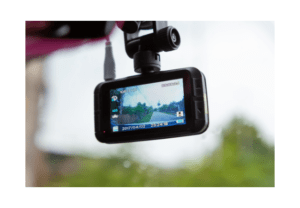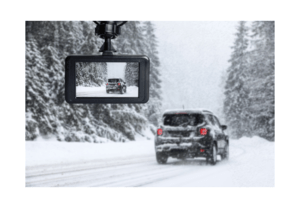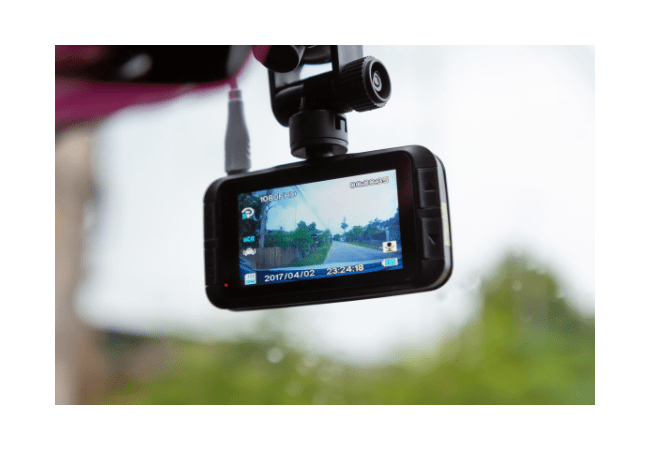A dashboard camera, commonly known as a dash cam, is a specialized onboard camera that mounts to the interior of a vehicle’s windshield or dashboard and continuously records the view through the front windscreen. It may also record the rear or interior of the vehicle if additional cameras are present. These devices have gained popularity as a means to document drives, capture unexpected events, and provide evidence in the case of an accident.
Dash cams vary in complexity from basic models, which record video to an internal storage device, to more advanced systems with a suite of extra features. Higher-end models may offer GPS tracking, connectivity to mobile devices, and the ability to integrate with other in-car technology systems. Further, certain dash cams come with parking mode, which enables the camera to record incidents even when the vehicle is switched off, increasing security when the car is unattended. These are many of the features when asked what is a dashboard camera.
Jump to
- 1 Understanding Dashboard Cameras
- 2 Practical Applications
- 3 Installation and Operation
- 4 Connectivity and Integration
- 5 Enhanced Features
- 6 Legal and Privacy Considerations
- 7 Product Recommendations
- 8 Installation and Technical Details
- 9 Accessibility and Additional Functions
- 10 Frequently Asked Questions about what is a dashboard camera
- 10.1 How do dashboard cameras operate when the vehicle is turned off?
- 10.2 What are common uses for a dashboard camera?
- 10.3 What should be considered when choosing the best dashboard camera?
- 10.4 Can dashboard cameras record the interior of the vehicle as well as the exterior?
- 10.5 Are there any potential drawbacks to installing a dashboard camera in your vehicle?
- 10.6 Why might it be beneficial to have a dashboard camera?
Key Takeaways
- Dash cams provide video documentation from a vehicle’s perspective.
- Advanced models offer features like GPS, mobile connectivity, and parking mode.
- These cameras can be crucial for legal evidence and security measures.
Understanding Dashboard Cameras
https://www.youtube.com/watch?v=5YKlaJL8If4&embed=true
Dashboard cameras, or dash cams, have become essential for many vehicle owners, offering a range of functionalities from recording road incidents to monitoring parked vehicles.
Definition and Basic Functions
A dashboard camera, commonly referred to as a dash cam, is a specialized onboard camera that mounts to the vehicle’s interior windscreen or to the top of the dashboard. Its basic function is to continuously record the road ahead while the vehicle is in motion. Most dash cams start recording once the vehicle’s ignition is turned on, capturing footage through a wide-angle lens to ensure a broad field of view. The recordings are typically saved on a removable storage device like a microSD card.
Types of Dash Cams
Dash cams come in various configurations:
- Single-lens dash cams record the road directly in front of the vehicle with considerable clarity. They are the simplest type and are sufficient for basic front-facing video recording.
- Dual-lens dash cams provide both front and rear recording capabilities, capturing footage from the front windscreen as well as the rearview.
- Multiple cameras can be installed for a more comprehensive surveillance system, which may include a rear-facing camera and an inside camera, aimed at monitoring both the exterior and interior of the vehicle.
Key Features to Look For
When purchasing a dash cam, key features to consider include:
- Resolution: Quality of footage varies; HD (High Definition) is standard, but many models offer 4K resolution for crisper images.
- Night Vision: Essential for clear recording in low-light conditions, night vision dash cams employ infrared or other technologies to capture detail in the dark.
- Field of View: A wider angle offers more coverage but can sometimes distort the image. A balance is crucial to ensure comprehensive recording without significant distortion.
- Storage Capacity: More storage allows for longer recording time before old footage is overwritten.
Additional features such as Wi-Fi connectivity, GPS tracking, and motion sensors may also be available and can offer extra layers of security and convenience.
Practical Applications
https://www.youtube.com/watch?v=I_cu3SXeksg&embed=true
Dashboard cameras serve as essential tools across multiple practical domains, from enhancing road safety to simplifying legal processes.
Safety and Accident Documentation
Dashboard cameras continuously record the vehicle’s front view, providing real-time evidence in the event of an accident. They can capture details like speed, impacting liability determinations. For emergency services, such footage is invaluable in understanding crash dynamics and responding appropriately.
Insurance Claims and Legal Evidence
Insurance companies heavily rely on dashboard camera footage when processing insurance claims. This video evidence can expedite claim settlements and serve as definitive proof in disputing liability. In legal scenarios, it provides law enforcement and the courts with unambiguous details that written reports may not capture.
Monitoring Driving Behavior
Rideshare drivers and fleet managers utilize dashboard cameras to monitor driving practices. They can observe speed compliance, adherence to traffic laws, and general road conduct. This helps in promoting safe driving behaviors and can be used in coaching drivers for improved performance.
Installation and Operation
When installing a dashboard camera, one must consider the proper mounting position, familiarize themselves with the device’s features, and understand the storage management to ensure smooth and effective operation.
Mounting and Positioning

The dashboard camera should be mounted on the windshield, making sure it does not obstruct the driver’s view. The correct position is typically behind the rearview mirror to capture a clear field of vision ahead. The process of fitting a dash cam starts with cleaning the area on the windshield where the suction cup or adhesive mount will be attached. Carefully align the camera before securing it to ensure full road coverage.
Setting Up and Using Features
A user must configure the dashboard camera by connecting it to a smartphone app if available. This often allows for easier management of settings and viewing of footage. Many dash cams come equipped with a microphone for audio recording and GPS to log location data. It’s essential to ensure these features are activated and functioning properly. Users can reference specific manufacturer guides for operations like setting the date and time, adjusting recording loops, and activating motion detection.
Maintenance and Storage Management
To maintain the dashboard camera, routinely clean the lens and check the mounts for security. For storage, dash cams typically use a removable SD card, which needs regular checks to ensure it is not full and functioning correctly. Users should format the SD card periodically within the camera to maintain file integrity and storage capacity. Proper storage management includes regularly transferring important video files to another device or cloud service to prevent automatic overwriting.
Connectivity and Integration
Modern dashboard cameras offer a variety of connectivity options to enhance user experience. They allow for seamless integration with other devices and services for real-time data management and control.
Smartphone Connectivity
Dashboard cameras can connect to a smartphone via Bluetooth or Wi-Fi. This connection enables users to:
- Live stream video footage directly to their phone.
- Download and save recordings to their smartphone’s storage.
- Adjust camera settings using a dedicated application.
Table: Connectivity Features and Functions
| Feature | Function |
|---|---|
| Bluetooth Pairing | Quick setup for live streaming and file transfer |
| Wi-Fi Connection | Ability to manage larger files and firmware updates |
Cloud Storage and Data Access
Many dashboard cameras offer integration with cloud storage services, allowing users to:
- Automatically upload footage for safekeeping.
- Access video files remotely from any internet-connected device.
- Share clips easily with contacts or on social media.
It’s essential for users to have reliable internet connectivity to utilize cloud functions efficiently.
Voice Commands and Control
Advanced dashboard cameras support voice commands and voice control, providing:
- Hands-free operation to increase driver safety.
- Commands to start/stop recording, take photographs, or save clips.
List of Common Voice Commands:
- “Start recording”
- “Stop recording”
- “Take a photo”
Integrating voice control technology enhances the ease of use for the driver and allows them to stay focused on the road.
Enhanced Features
Modern dashboard cameras offer an array of advanced features that cater to both security and convenience needs for drivers. These innovations extend beyond basic recording functions, providing continuous monitoring and assistance technologies for a safer driving experience.
Parking Mode and Surveillance
Dashboard cameras equipped with parking mode offer drivers peace of mind by continuing to record even when the car is parked. They often include a g-sensor, which detects sudden movement or impact, prompting the camera to save the footage of any incidents that occur. This feature is crucial for 24-hour parked-car monitoring, helping to capture events like break-ins or hit-and-run accidents when the driver is away from the vehicle.
Many dashboard cameras now come with GPS tracking, allowing drivers to record their vehicle’s location and speed alongside their video footage. This can be especially useful in the case of an accident or for reviewing travel history. Some models also integrate with navigation systems to provide real-time directions, combining convenience with tracking functionality.
Advanced Driver Assistance Systems
Dashboard cameras have evolved to include Advanced Driver Assistance Systems (ADAS), which assist drivers with safety monitoring. Features like lane departure warnings and collision alerts help prevent accidents. A wide-angle front camera can capture a comprehensive view of the road ahead, giving drivers better situational awareness. Additionally, certain models are equipped with emergency calling capabilities, which can automatically contact services in the event of a serious accident, enhancing overall safety.
Legal and Privacy Considerations
When discussing dashboard cameras, it’s important to recognize that they are subject to varying legislation and raise significant privacy concerns. One must navigate carefully through the legal frameworks and ethical implications of using such devices.
Understanding Dash Cam Laws
In the United States, dash cam laws vary by state; however, they generally allow the use of dashboard cameras as long as they do not obstruct the driver’s view. Specific regulations can include:
- Mounting: Some states have restrictions on where a dash cam can be placed on the windshield.
- Audio Recording: Consent laws for recording conversations differ. Some states mandate dual-party consent, making it illegal to record audio without the knowledge and agreement of all parties involved.
- Visibility: It is crucial that dash cams do not impede the visibility of the driver, potentially leading to legal repercussions.
One should always check their state’s specific laws to stay compliant.
Privacy Issues and Ethics
Privacy considerations are essential when operating a dash cam. These relate to:
- Expectation of Public Privacy: While recording in public spaces is often legal, individuals may maintain a reasonable expectation of privacy in certain scenarios.
- Disclosure: Ethically, notifying passengers that they are being recorded by a dash cam is advisable.
- Data Protection: Owners of dashboard cameras are responsible for the security of the footage they collect, ensuring that others’ privacy rights are not violated.
Owners must manage the data responsibly and adhere to any laws regarding the collection and storage of such recordings.
Product Recommendations
When searching for the perfect dashboard camera, it’s essential to consider your needs, budget, and desired features. This section offers recommendations to help you find a dash cam that aligns with your specific requirements.
Choosing the Best Dash Cam for Your Needs
The best dash cam for any driver depends on several factors, including video quality, reliability, and extra features. For those seeking top-notch image clarity, the Nextbase 622GW is an excellent choice as it offers 4K recording capability. Its superior night vision and image stabilization set it apart as one of the best overall options. For users who prioritize connectivity, the Garmin Dash Cam Live with its 4G LTE features allows for remote vehicle monitoring.
Budget-Friendly Options
It’s possible to secure a reliable dash camera without spending a fortune. The Thinkware F70 is known as the best value budget dash cam, offering essential features like HD recording and a compact design. Another budget-friendly option is the Garmin Dash Cam Mini 2, notable for its diminutive size and straightforward functionality.
High-End Dash Cam Features
For those interested in more advanced features, the Vantrue N4 provides a 3-channel camera system capturing the front, interior, and rear views simultaneously in high definition. It satisfies users looking for comprehensive coverage. Alternatively, for a smart dash cam experience, the Thinkware U1000 offers 4K resolution and features like cloud connectivity, making it a best value 4K choice. The Ring Car Cam is another high-end device that integrates smart security functions for added peace of mind while your vehicle is parked.
| Feature | Model | Benefit |
|---|---|---|
| Best Overall 4K | Nextbase 622GW | Crystal-clear footage |
| Budget Dash Cam | Thinkware F70 | Affordability with essential features |
| Smart Dash Cam | Garmin Dash Cam Live | Live monitoring over 4G |
| Best Value 4K | Thinkware U1000 | High definition with cloud features |
| Multi-Channel Recording | Vantrue N4 | Simultaneous front, interior, rear capture |
Remember, the selection of a dash cam should be influenced by the specific needs and preferences of the user, from simple recording to sophisticated monitoring.
Installation and Technical Details

When installing a dashboard camera, consumers must consider power source options and understand the device’s storage requirements. These factors significantly dictate the functionality and maintenance of the device.
Hardwiring vs. Plug-in Power
Dashboard cameras can be powered in two primary ways: by hardwiring to the vehicle’s electrical system or through a plug-in power supply such as the car’s cigarette lighter socket. Hardwiring a dashboard camera allows for a cleaner installation and enables the camera to continuously record when the vehicle is parked by drawing power from the car battery. This installation often involves connecting the camera to the fuse box, which should be done by a professional to ensure safety. Hardwired dashcams usually employ a capacitor as a power supply instead of traditional batteries, providing improved heat resistance and a longer lifespan.
| Power Source | Advantages | Disadvantages |
|---|---|---|
| Hardwiring | – Hidden cables – Enables parking mode recording |
– More complex installation – Potential vehicle warranty issues |
| Plug-in | – Easy to install and remove – No alteration to the vehicle’s wiring |
– Visible cables – Usually does not support parking mode without extra hardware |
Understanding Storage Capabilities
The storage capacity of dashboard cameras determines how much footage can be stored before it needs to be overwritten or offloaded. Most cameras under $100 support microSD cards, which are not included and must be purchased separately. It’s recommended to buy a high-endurance microSD card that can withstand the continuous recording cycle. The size of the storage can vary, but commonly, cards ranging from 32GB to 256GB are used, with larger capacities allowing for more hours of footage.
To manage storage, dashcams typically use a loop recording feature where old footage is overwritten by new content. However, important clips triggered by an incident (such as sudden braking) are protected from being overwritten. A dashboard camera with a higher resolution will require more storage space for the same amount of footage.
- Recommended Storage Size
- For 1080p resolution: Minimum 64GB
- For 4K resolution: Minimum 128GB
When choosing a dashboard camera, assessing the compatibility with different storage sizes and ensuring it meets recording needs are crucial.
Accessibility and Additional Functions
Advanced dashboard cameras offer diverse features that enhance user interaction and extend functionality, addressing both ease of accessibility for drivers and incorporating expansive capabilities for a comprehensive driving experience.
Ease of Use and Accessibility Features
Modern dashboard cameras integrate with the vehicle’s systems to provide an accessible interface for users. Many models feature touch-sensitive screens, allowing drivers to operate the camera without significant distraction from the road. For instance, cameras designed to attach to the rearview mirror facilitate accessibility by placing controls within reach and visibility. Additionally, voice commands have become a standard feature, with built-in Alexa support enabling drivers to issue commands, place orders, or control other smart devices hands-free, thereby enhancing safety and convenience.
Extra Functions for a Comprehensive Experience
Aside from capturing footage, dashboard cameras now encompass a range of extra functions:
- Protection: Certain cameras include an emergency SOS feature that alerts emergency services of the vehicle’s location after a serious accident.
- Ride-Sharing: For Uber and other ride-sharing services, dashboard cameras can serve as an essential tool for driver protection and dispute resolution.
- Road Trips: When embarking on a road trip, some cameras offer additional functions like travelogue recording and GPS tracking to enrich the travel experience.
The functionalities of dashboard cameras have grown to accommodate the evolving needs of drivers, making them indispensable tools for protection, convenience, and capturing memories on the road.
Frequently Asked Questions about what is a dashboard camera
In this section, we cover the most pertinent inquiries related to dashboard cameras, providing clarity on their operation, practical uses, selection criteria, recording capabilities, potential disadvantages, and benefits.
How do dashboard cameras operate when the vehicle is turned off?
Many dashboard cameras come equipped with a feature that allows them to operate in a standby mode, enabling them to record if they detect motion or an impact using a built-in battery or a hardwiring kit connected to the vehicle’s battery.
What are common uses for a dashboard camera?
Dashboard cameras are often used to record driving footage for the purpose of security, evidence in the event of an accident, monitoring driving habits and capturing unexpected events on the road.
What should be considered when choosing the best dashboard camera?
When selecting a dashboard camera, potential buyers should consider video quality, storage capacity, ease of use, additional features like GPS and Wi-Fi connectivity, as well as the camera’s reliability and the manufacturer’s customer service reputation.
Can dashboard cameras record the interior of the vehicle as well as the exterior?
Some dashboard cameras are designed with dual lenses to record both the interior of the vehicle and the exterior simultaneously, which can be particularly useful for ride-sharing drivers or those who wish to monitor the activity inside the car while driving.
Are there any potential drawbacks to installing a dashboard camera in your vehicle?
Possible drawbacks may include potential distraction, privacy concerns for passengers, legal restrictions on recording in certain jurisdictions, and the risk of theft if the camera is visible and appears valuable.
Why might it be beneficial to have a dashboard camera?
Having a dashboard camera can be advantageous for documentation purposes following traffic incidents, for disputing traffic tickets, for insurance claims, for deterring break-ins or vandalism, and for capturing scenic drives or unexpected events.

My name is Tom Harris, founder of this blog. I’m a mechanical engineer with 20 years of experience in the automotive industry. I’m here to help you with your vehicle’s problems, easy fixes and share my insights and experience so that you can enjoy your rides more.

